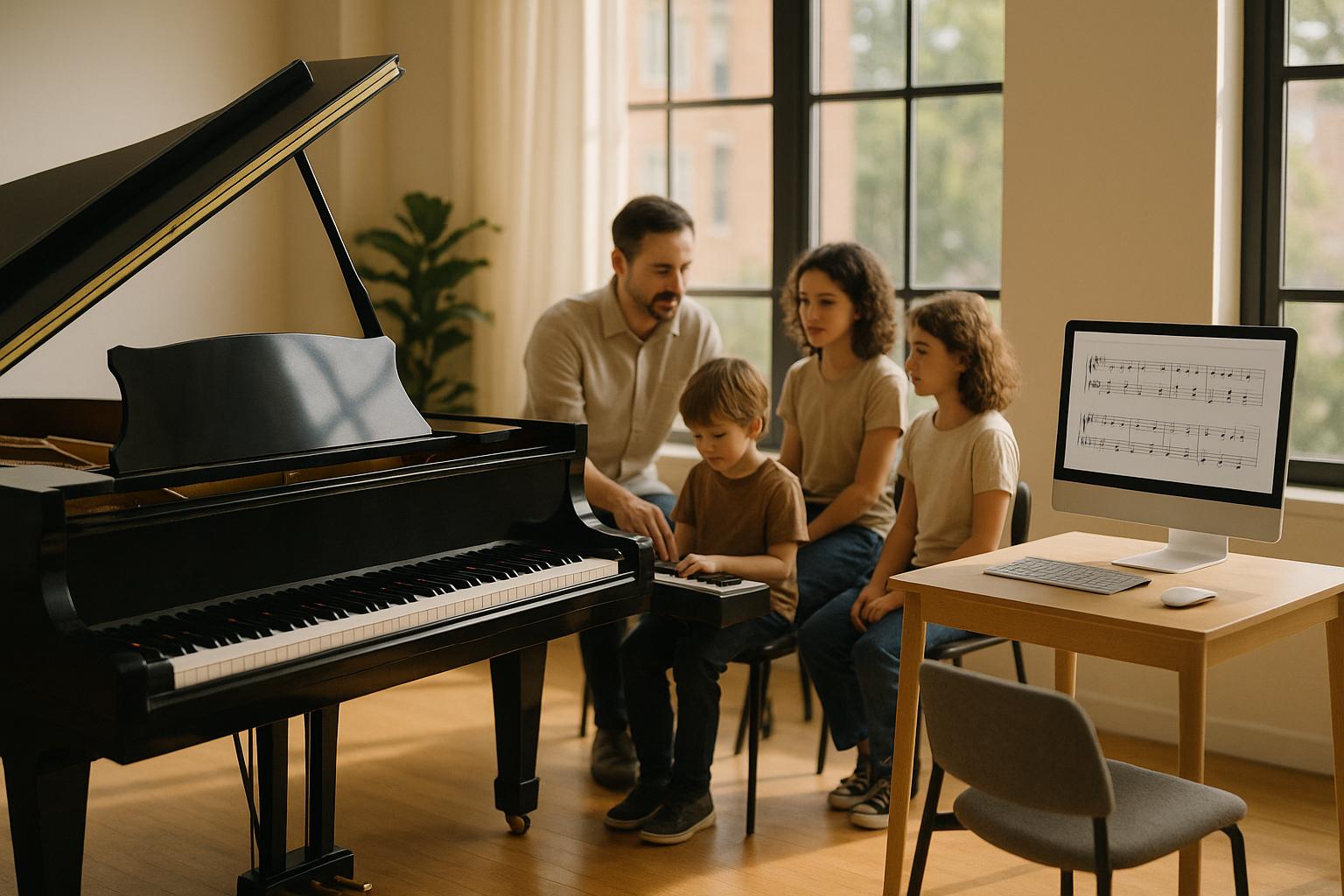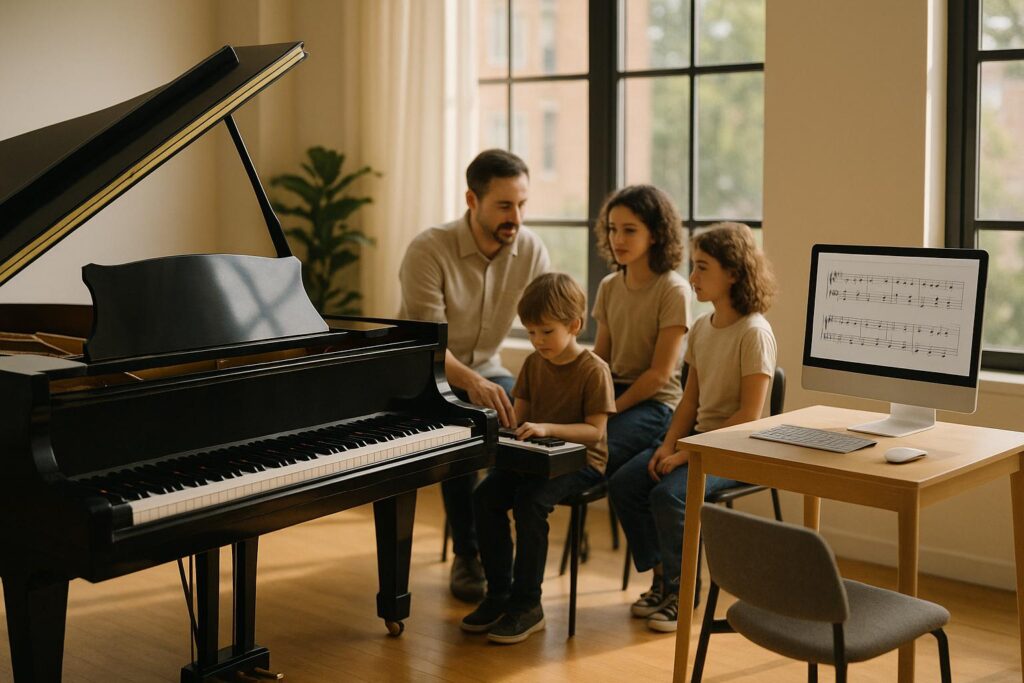
Learning to play the piano is a deeply rewarding experience, whether it’s for personal fulfillment or fostering a child’s creativity. However, the wide variety of lesson formats – private, group, online, or self-paced – can make choosing the right option feel overwhelming. Each approach has its own unique advantages and potential drawbacks, depending on your goals, lifestyle, and budget. This guide dives into the nuances of each format to help you make an informed decision.
The Gold Standard: Private One-on-One Piano Lessons
One-on-one lessons, especially in-person, have long been considered the most effective method for learning the piano. Individualized attention allows the teacher to tailor the lesson to the student’s specific goals, strengths, and weaknesses. According to educational research, such as the renowned "Two Sigma Problem" study by Benjamin Bloom, private tutoring can elevate a student’s performance significantly compared to group instruction.
Benefits of Private Lessons:
- Customized Feedback: Teachers can identify and address specific areas for improvement in real time.
- Performance Benefits: Playing duets and receiving hands-on guidance is easier in person.
- Accelerated Progress: The focused attention often leads to faster skill development compared to other formats.
Drawbacks of Private Lessons:
- Cost: Private lessons are the most expensive option. If the teacher travels to your home, additional fees may apply to cover their time and transportation.
- Scheduling Challenges: Busy families or professionals may struggle to fit regular lessons into their schedules.
- Convenience: Traveling to a teacher’s studio can be inconvenient for some.
Who Should Consider This Option?
Private lessons are ideal for individuals seeking a structured, immersive learning experience and are willing to invest more time and money for faster results. They are also particularly beneficial for young children who may need close guidance and interactive feedback.
The Modern Solution: Online One-on-One Lessons
Online lessons have surged in popularity, offering a convenient and effective alternative to in-person instruction. Thanks to platforms like Zoom and FaceTime, you can connect with skilled teachers from anywhere in the world, maintaining the personalized approach of private lessons.
Benefits of Online Lessons:
- Convenience: No need to leave your home, making it easier to fit lessons into a busy schedule.
- Comparable Quality: Online lessons provide the same tailored feedback and progress tracking as in-person lessons.
- Flexible Rescheduling: Teachers and students can more easily coordinate lesson times without geographical constraints.
Drawbacks of Online Lessons:
- Technology Barriers: Setting up cameras, microphones, and proper angles can be challenging, especially for beginners.
- Engagement Issues: Younger students may find it harder to stay focused without a teacher physically present.
- Playing Duets: The limitations of most video conferencing platforms make real-time music collaboration difficult.
Who Should Consider This Option?
If you’re tech-savvy and value flexibility, online lessons can be a great fit. They’re also ideal for those who don’t have access to a high-quality teacher nearby.
The Social Approach: Group Lessons (In-Person or Online)
Group piano lessons can be a fun and affordable way to learn, particularly for extroverted learners who thrive in social environments. These classes often involve multiple students learning together, creating opportunities for collaboration and peer motivation.
Benefits of Group Lessons:
- Community Learning: Students can connect with peers who share similar interests.
- Affordability: Group classes are significantly cheaper than private lessons – sometimes as little as one-fourth the price.
- Collaborative Skills: Students gain experience playing with others, an essential skill for ensemble performance.
Drawbacks of Group Lessons:
- Slower Progress: Teachers need to balance the pace of the entire group, which may not align with individual learning speeds.
- Limited Individual Attention: Students may not receive the same level of personalized feedback as in private lessons.
- Age Considerations: Younger children may struggle to stay focused in larger group settings.
Who Should Consider This Option?
Group lessons work well for beginners, older children, and adults who enjoy learning in a social setting. They’re also a great choice for those on a tight budget or those seeking a lower-pressure introduction to piano.
Go at Your Own Pace: Self-Paced Courses
The rise of self-paced piano courses and apps, such as Simply Piano, has opened the door for independent learners. These programs are cost-effective and allow complete flexibility, but they lack the personalized touch of a teacher.
Benefits of Self-Paced Courses:
- Flexibility: Study whenever and wherever you want, making it ideal for busy schedules.
- Low Cost: Many self-paced courses are affordable, especially compared to private lessons.
- Structured Learning: High-quality courses provide a clear curriculum, unlike randomly searching for tutorials online.
Drawbacks of Self-Paced Courses:
- Lack of Feedback: It’s easy to develop bad habits without a teacher’s guidance.
- Limited Accountability: Without a scheduled lesson, it can be harder to stay motivated.
- Skill Gaps: Students may overlook important foundational skills, such as reading sheet music, which can inhibit long-term growth.
Who Should Consider This Option?
Self-paced courses are a good fit for those who prefer autonomy and are comfortable learning without direct supervision. They work best as a supplement to other forms of piano education or for casual learners.
Combining Methods: A Flexible Approach
One of the key insights from piano teacher John Halawati is the ability to blend different learning methods. For example:
- Pairing self-paced courses with occasional private lessons for troubleshooting.
- Alternating between online lessons and in-person group classes.
- Requesting shorter, more frequent private lessons to reduce costs.
By customizing your approach, you can find a balance that fits your goals, budget, and lifestyle.
Key Takeaways
- Private Lessons: Best for tailored, accelerated learning but can be costly and less convenient.
- Online Lessons: Comparable to private lessons in quality, with added flexibility, but may require technical setup.
- Group Lessons: Affordable and social, but progress is slower, and individual attention is limited.
- Self-Paced Courses: Budget-friendly and flexible but lack feedback and accountability.
- Blended Approach: Combining methods can optimize learning efficiency and affordability.
Closing Thoughts: Focus on Enjoyment
Whether you’re a beginner or an experienced player looking to refine your skills, the most important factor is choosing a method that aligns with your personal goals and circumstances. Remember, the purpose of learning piano isn’t just about technical mastery – it’s about finding joy in the music. You don’t have to aim for perfection or professional-level performance. Let the process of learning be as enjoyable as the music itself.
Every path has its merits. Whether you decide on private lessons, online instruction, group settings, or self-paced courses, make sure it’s a choice that nurtures your enthusiasm and curiosity. Happy playing!
Source: "Private vs Group vs Online: What’s the BEST Way to Learn Piano?" – MusicTeacherJon, YouTube, Sep 11, 2025 – https://www.youtube.com/watch?v=LghMc-j4wq8
Use: Embedded for reference. Brief quotes used for commentary/review.

